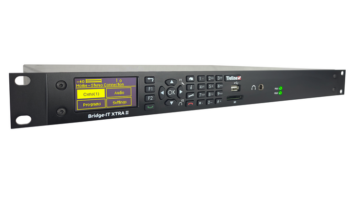
Keyur Parikh, Harris Intraplex System Architect and Software Lead. ‘Because the algorithms are more or less standard, the differentiation of products comes from being able to adapt to IP networks.’
Radio World asked several codec suppliers about trends in their area of expertise and we got back some great information. Here, we talk with Keyur Parikh, Harris Intraplex system architect and software lead. This is one in a series.
Let’s say I’m an engineer but I’ve been out of the market for several years. What’s the most notable way that codecs are different now?
Parikh: A major difference is the transport model. Circuit-based networks with high recurring costs are now being replaced with lower-cost ubiquitous IP networks (both wired and wireless). In fact, it is not uncommon for users to have access to multiple IP paths connecting the transmit end to the receiver for resiliency. Another trend is the use of newer algorithms such as the AAC family of codecs, which can provide near-linear quality using a fraction of bandwidth used by linear PCM.
In what direction is codec design heading?
Parikh: Increasing processor speeds have allowed codecs to be implemented in software. The software implementation has enabled flexibility in reconfiguration of codec algorithms on the fly as well as integrating IP networking features. As codecs increasingly become IP-based, inter-operable standards for real-time and Web streaming are becoming prevalent. EBU has put out a standard that is based on RTP streaming for interoperability. By adapting protocols such as Shoutcast and the ability to stream using Shoutcast as well as RTP for broadcasting, codecs are extending their real-time broadcasting reach to PCs and smartphones as well.
What’s your take on Internet reliability for mission-critical transport?
Parikh: Internet comes in many flavors: from a managed IP service to unmanaged public Internet. Managed service can provide reliable/deterministic service (almost like a circuit service). With public Internet, there are no guarantees on the quality of service. A user is still leery of the Internet, but a well-designed codec in today’s market will provide multiple tools in its networking features kit to combat impairments in the IP networks. These tools include, but are not limited to, interfaces for multiple IP paths to be used simultaneously, forward error correction and advanced features which can provide hitless protection switching. All of the above enable the user to achieve the reliability of a circuit connection with a lot less recurring cost.
What’s the “state of the art” in bitrates and algorithms?
Parikh: For musical content, the AAC codecs are state of the art these days. AAC-HEv2 can achieve 90 percent of linear quality at 64 kbps. HE and HEv2 are specified in various broadcast standards such as XM Radio, Mobile Handheld, DAB+, DRM. On consumer side, Apple’s iTunes also uses AAC as its default codec. AAC also has a low-delay option, however for some user scenarios, this is still not low enough and therefore users would have to consider other options such as linear or APT codec. For wideband voice, G722 is still a very good option. It is low-delay and royalty-free.
What is the next big challenge for codec designers?
Parikh: The challenge for codec designers is to create network adaptable systems. Because IP networks come in various qualities, the codec needs to be able to tailor its transmission and algorithm for each path simultaneously. For example, when content is to be sent to multiple receivers over different IP networks simultaneously, the codec needs to use the optimal algorithm for each receiver. Receivers with high-speed connections may be sent uncompressed content, while ones with lower bandwidth and reliability should be sent content with appropriate compression and with network layer reliability features enabled.
What question should a smart buyer of codecs be asking?
Parikh: Because the algorithms are more or less standard, the differentiation of products comes from being able to adapt to IP networks. Specifically, the ability to simultaneously encode the same content with different algorithms and bitrates with different network layer reliability handling is a key. Having multiple interfaces and providing “hitless” operation using them is important. Providing advanced features which can send multiple copies of the same packets in a time-dispersed manner and intelligently resequence them at the receiver is key to combating packet erasure. RTP level forward error correction is another technique that is used to recover lost packets.
What is your newest or most notable codec product?
Parikh: The new Harris IP Link 100 and IP Link 200 Audio Codecs carry on the Intraplex tradition of robust “Always On Audio” for STL and high-reliability audio networking applications. The IP Link platform provides user-configurable encoding options along with advanced capabilities for operation on managed or unmanaged IP networks. Key features include dual WAN interfaces for streaming over diverse networks; simultaneous multi-coding of a single audio source onto multiple streams with different algorithms and/or bitrates; and Dynamic Stream Splicing for protection against packet loss and “hitless” recovery of the audio stream.
Comment on this or any story. Email [email protected] with “Letter to the Editor” in the subject field.
_







